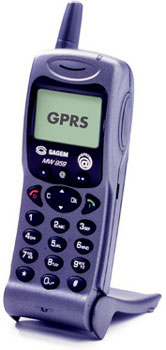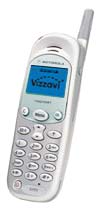Introduction The
GPRS References Conclusion

SAGEM
GPRS
Mobile Phone |
Introduction: GPRS (General Packet Radio
Service) is a packet data communications system
integrated with the GSM cellular telephone
system. Standardized by ETSI in December 1997,
GPRS products are currently under development by
GSM equipment vendors. GPRS is a large, complex
system that merges cellular telephone radio
transmission technology and Internet information
delivery protocols. Initial implementations of
GPRS will operate within the framework of present
GSM technology. It is also anticipated that GPRS
will be adapted for use in North American TDMA
cellular systems and enhanced TDMA cellular
systems (EDGE).
The GPRS specification admits considerable
flexibility in the design of network elements and
in network operation. The values assigned to a
large set of parameters influence many
performance characteristics including the
relationship of GPRS data transmissions to GSM
telephone traffic, the relationship of uplink
data traffic to downlink data traffic, and the
proportion of resources devoted to signaling and
user data.
Home
|

Motorola
Timeport T260 GPRS Mobile Phone
|
The
GPRS:The GPRS is an extension of the
GSM network enabling data "packets" to
be transmitted at high speed, in the same way as
on the Internet. With rates up to eight times
higher than GSM, the network offers virtually
instantaneous connection.
Thanks to GPRS, SAGEM mobile phones will enable
you to surf the WEB as easily as you can today
with a modem and PC, but with the added mobility.
The GPRS world premiere was at TELECOM Geneva 99,
where it successfully passed its first test with
an Internet access from a "monoslot"
1+1 SAGEM GSM. This was confirmed two months
later when an MC 850 GPRS "multislot"
3+1* mobile was used at the "Semaine des
Télécoms 99" in Paris. During the Cebit
2000 in Hannover, SAGEM demonstrated successful
mobile Internet access at a rate of 53.6 kbit/s,
using a 4+1* "multislot" GSM/GPRS
on-going connection [3].
Home
|
GPRS
offers packet-switched connections to data
networks via mobile technology. It is designed to
allow faster and easier Internet access with
continuous connectivity, and enables applications
including multimedia messaging, wireless
corporate intranet, remote control and
maintenance of appliances. It is also considered
part of the migration to third generation (3G)
mobile networks [4].
The advantages of GPRS technology allows users to
stay connected to the Internet by using packet
switching technology providing faster downloads
as no time is spent attempting to access a
dial-up connection. A users favorite information
and entertainment sites are always available via
GPRS without having to maintain a continuous
phone call [8].
Not only does Vodafone's GPRS service greatly
enhance your WAP experience, it also lets you
stay permanently connected to the mobile Internet
without running up a huge phone bill. This is
because with GPRS, you are only charged for the
amount of information you send and receive, not
the length of time you use your phone. This means
that once switch on your GPRS phone in the
morning and connect to the mobile Internet, you
can stay on all day - you don't need to connect
and disconnect to the Net each time you want to
access a service. This is known as being
"always on" because your GPRS phone is
always ready for you to use the mobile Internet,
saving you time and hassle.
The "always on" capability of GPRS
means that you don't need to worry about your
mobile Internet session being interrupted by
phone calls either. With Vodafone's GPRS service,
you can simply pause your browsing session, take
the call, and then carry on reading the page you
were on already. It's another handy timesaving
function of GPRS that enhances your enjoyment of
WAP.
So with Vodafone's new GRPS service and Vizzavi's
WAP site, you can access the information you need
at lightning speed and have the timesaving
convenience of being permanently connected to the
mobile Internet [9].
Anite Telecoms has been monitoring GPRS from a
user's perspective with its wireless data
performance tool, WAM, which the company launched
earlier this month. It has so far only recorded
data transfer rates of 8kbit/s much lower than
predicted.
Anite's business manager for WAM, Warren
Saunders, said he was surprised to see that data
transfer rates were lower than those predicted by
companies offering the service. "We were
amazed that the wireless data revolution, like
WAP before it, is less than impressive," he
said [10].
GPRS is a packet-based wireless communication
service that, promises data rates from 56 up to
114 Kbps and continuous connection to the
Internet for mobile phone and computer users GPRS
is based on "regular" GSM (with the
same modulation) and will complement existing
services such circuit-switched cellular phone
connections such as SMS or cell broadcast. Voice
over Ip over GPRS is also explored.
In theory, GPRS packet-based service should cost
users less than circuit-switched services since
communication channels are being used on a
shared-use, as-packets-are-needed basis rather
than dedicated only to one user at a time. It
should also be easier to make applications
available to mobile users and Wap or i-mode
should far more attractive for the user. In
addition to the Internet Protocol GPRS supports
X.25, a packet-based protocol that is used mainly
in Europe.
Operator should deploy GPRS very fast as most of
the interoperability test between the network and
the Handset are now finished (September'00) and
because GPRS is mainly a software upgrade for the
BTS, BSC and servers [12].
GPRS data speeds are expected to reach 100 Kbps.
Another GSM 2.5G packet technology, Enhanced Data
rates for GSM Evolution (EDGE), will boost data
rates to 384 Kbps if/when deployed.
Beginning in the 2nd half of 2001, Europe will
transition to 3G, by uptaking 2.5G GPRS services.
The overall growth rate will decline, the
migration of users from "Basic GSM" to
GPRS, and ultimately to W-CDMA (starting in
2003), will provide a new 'revenue engine'for
operators and manufacturers.Home
|
Conclusion
I
would be happy to receive topics written by you
if you feel in this writing mood. Also, there is
no need to email me asking whether you can link
to my site, or put these on your pages - its fine
as long as you don't edit them in any way. If
there is anything you would like me to consider
putting into my file, please email me at:
boostan@tci-khorasan.com
Mahdi Boostanpour
12 Nov 2001
|
Home
© 12 November 2001
All Rights Reserved
|